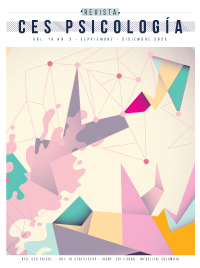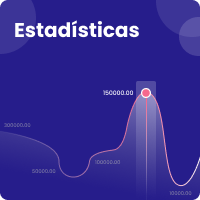Percepción subjetiva del COVID-19: Una medida de evaluación integral para adolescentes y jóvenes
DOI:
https://doi.org/10.21615/cesp.6143Palabras clave:
COVID-19, jóvenes, adolescentes, evaluación, propiedades psicométricas, percepción subjetivaResumen
La pandemia por COVID-19 es un evento adverso y factor de riesgo para la salud integral de los adolescentes y jóvenes, asociado a trastornos de estrés, ansiedad y depresión, sin embargo, la perspectiva ecológica plantea que la percepción del evento o situación juega un papel central en la adaptación y salud mental. Por otra parte, la detección de factores de riesgo-protección es la base de una intervención efectiva. El objetivo de este estudio fue construir una medida multidimensional válida y confiable para explorar la percepción subjetiva y las respuestas psicológicas de los adolescentes y jóvenes ante la pandemia por COVID-19. Se realizó un estudio instrumental en el que participaron 727 adolescentes de 13 a 24 años (M= 18.36; DE= 2.9) de la Ciudad de México. Se elaboró la Encuesta de Percepción Juvenil del COVID-19 (EPJ COVID-19) que fue aplicada en línea. Un análisis factorial por componentes principales (n= 410) arrojó una solución de ocho factores: Miedo y preocupaciones, Indicadores de estrés, Presiones escolares, Conductas preventivas, Cambios de rutinas, Dinámica familiar, Relajación y esparcimiento, y Socialización virtual (VE = 59.07%). Un análisis factorial confirmatorio con el método de máxima verosimilitud (n= 317) corroboró un modelo de ocho factores mostrando índices aceptables de ajuste, el cual también presentó una buena consistencia interna (α total= .863). Los resultados sugieren que la EPJ COVID-19 es una medida válida y confiable que puede ser usada para valorar de manera integral la percepción y respuestas de los adolescentes y jóvenes ante la pandemia para diseñar intervenciones basadas en evidencia.
Descargas
Referencias bibliográficas
Ahorsu, D. K., Lin, C. Y., Imani, V., Saffari, M., Griffiths, M. D., & Pakpour, A. H. (2020). The fear of COVID-19 scale: development and initial validation. International Journal of Mental Health and Addiction, 1-9. https://doi.org/10.1007/s11469-020-00270-8
Ato, M., López-García, J. J., & Benavente, A. (2013). Un sistema de clasificación de los diseños de investigación en psicología. Anales de Psicología/Annals of Psychology, 29(3), 1038-1059. http://dx.doi.org/10.6018/analesps.29.3.178511
Bazán, C., Brückner F., Giacomazzo, D., Gutiérrez, M., & Maffeo, F. (2020). Adolescentes, COVID-19 y aislamiento social, preventivo y obligatorio. FUSA. https://grupofusa.org/wp-content/uploads/2020/05/Adolescentes-COVID-19-y-aislamiento-social.pdf
Becker, S., & Gregory, A. (2020). Editorial Perspective: Perils and promise for child and adolescent sleep and associated psychopathology during the COVID-19 pandemic. Journal of Child Psychology and Psychiatry, 4-6. https://doi.org/10.1111/jcpp.13278
Bonanno, G. A., Brewin, C. R., Kaniasty, K., & La Greca, A. M. (2010). Weighing the costs of disaster: Consequences, risks, and resilience in individuals, families, and communities. Psychological Science in the Public Interest, 11(1), 1-49. https://doi.org/10.1177/1529100610387086
Buzzi, C., Tucci, M., Ciprandi, R., Brambilla, I., Caimmi, S., Ciprandi, G., & Marseglia, G. L. (2020). The psycho-social effects of COVID-19 on Italian adolescents’ attitudes and behaviors. Italian Journal of Pediatrics, 46(69), 1-7. https://doi.org/10.1186/s13052-020-00833-4
Byrne, B. M. (2016). Structural equation modeling with Amos. 3rd Edition. Taylor & Francis
Cao, W., Fang, Z., Hou, G., Han, M., Xu, X., Dong, J., & Zheng, J. (2020). The psychological impact of the COVID-19 epidemic on college students in China. Psychiatry Research, 287, 0165-1781. https://doi.org/10.1016/j.psychres.2020.112934
Çetin, M., & Kökalan, Ö. (2021). A multilevel analysis of the effects of indoor activities on psychological wellbeing during COVID-19 pandemic. Anales de Psicología/Annals of Psychology, 37(3), 500-507. https://doi.org/10.6018/analesps.446891
Comisión Nacional para la Protección de los Sujetos Humanos de Investigación Biomédica y del Comportamiento. (2010). Principios y guías éticos para la protección de los sujetos humanos de investigación. Informe Belmont. http://pcb.ub.edu/bioeticaidret/archivos/norm/InformeBelmont.pdf
Drury, J., Carter, H., Cocking, C., Ntontis, E., Tekin Guven, S., & Amlôt, R. (2019). Facilitating collective psychosocial resilience in the public in emergencies: Twelve recommendations based on the social identity approach. Front Public Health, 6(7), 1141-149. https://doi.org/10.3389/fpubh.2019.00141
Dyregrov A., Yule W., & Olff, M. (2018). Children and natural disasters. European Journal of Psycho-Traumatology, 9(2), 1-14. https://doi:10.1080/20008198.2018.1500823
Evans, S., Alkan, E., Bhangoo, J., Tenenbaum, H., & Ng-Knight, T. (2021). Effects of the COVID-19 lockdown on mental health, wellbeing, sleep, and alcohol use in a UK student sample. Psychiatry Research, 0165-1781. https://doi.org/10.1016/j.psychres.2021.113819
Ferrando, P., & Anguiano, C. (2010). El análisis factorial como técnica de investigación en psicología. Papeles del Psicólogo, 31(1), 18-33.
Gignac, G. E., & Szodorai, E. T. (2016). Effect size guidelines for individual differences researchers. Personality and Individual Differences, 102, 74-78. https://doi.org/10.1016/j.paid.2016.06.069
Golberstein, E., Wen, H., & Miller, B.F. (2020). Coronavirus disease 2019 (COVID-19) and mental health for children and adolescents. JAMA Pediatrics, 174(9), 819-820. http://doi.org/10.1001/jamapediatrics.2020.1456
Güner, R., Hasanoğlu, I., & Aktaş, F. (2020). COVID-19: Prevention and control measures in community. Turkish Journal of Medical Sciences, 50, 571–577. http://doi.org/10.3906/sag-2004-146
Hall, J. A., & Ochoa-Martínez, P. Y. (2020). Enseñanza virtual en educación física en primaria en México y la pandemia por COVID-19. Revista Ciencias de la Actividad Física, 21, 1-7. https://doi.org/10.29035/rcaf.21.2.4
Hernández, R. A. (2020). Covid-19 y América Latina y el Caribe: los efectos económicos diferenciales en la región. http://hdl.handle.net/10017/43143
IBM. (2017). Statistical Package for Social Sciences (SPSS) 25. Armonk, NY, USA: IBM Corporation.
Instituto Nacional de Estadística, Geografía e Informática [INEGI]. (2019). Encuesta Nacional sobre Disponibilidad y Uso de Tecnologías de la Información en los Hogares. https://www.inegi.org.mx/temas/ticshogares/default.html
Lazarus, R., & Folkman, S. (1991). Estrés y procesos cognitivos. Martínez Roca
Lee, J. (2020). Mental health effects of school closures during COVID-19. The Lancet Child & Adolescent Health, 4(6), 421. http://doi.org/10.1016/S2352-4642(20)30109-7
Lei, L., Huang, X., Zhang, S., Yang, J., Yang, L., & Xu, M. (2020). Comparison of prevalence and associated factors of anxiety and depression among people affected by versus people unaffected by quarantine during the COVID-19 epidemic in southwestern China. Medical Science Monitor, 12(1), 1-17. http://doi.org/10.12659/MSM.924609
Liu, X., Luo, W.T., Li, Y., Li, C.N., Hong, Z.S., Chen, H.L., … Xia J.Y. (2020). Psychological status and behavior changes of the public during the COVID-19 epidemic in China, Infectous Disease of Poverty, 9(58), 1-19. http://doi.org/10.1186/s40249-020-00678-3
Lloret-Segura, S., Ferreres-Traver, A., Hernández-Baeza, A., & Tomás-Marco, I. (2014). El análisis factorial exploratorio de los ítems: una guía práctica, revisada y actualizada. Anales de Psicología/Annals of Psychology, 30(3), 1151-1169. http://dx.doi.org/10.6018/analesps.30.3.19936
Martínez, T. Y., Bernal, S., Mora, A., & Hun, N. (2020). Percepción subjetiva de manejo emocional, ansiedad y patrones de ingesta relacionados con aislamiento por COVID-19. Universitas Psychologica, 19, 1-9. https://doi.org/10.11144/Javeriana.upsy19.epbi
Medina-Valencia, R. T., Andrade-Sánchez, A. I., & Ramos-Carranza, I. G. (2020). La recreación en adolescentes mexicanos durante el confinamiento por Covid-19. Lecturas: Educación Física y Deportes, 25(271), 22-34. https://doi.org/10.46642/efd.v25i271.2549
Nunnally, J., & Bernstein, I. (1995). Teoría Psicométrica. McGraw-Hill.
Oosterhoff, B., Palmer, C. A., Wilson, J., & Shook, N. (2020). Adolescents’ motivations to engage in social distancing during the COVID-19 pandemic: Associations with mental and social health. Journal of Adolescent Health, 1-7. https://doi.org/10.1016/j.jadohealth.2020.05.004
Organización Panamericana de la Salud [OPS]. (2016). Protección de la salud mental y atención psicosocial en situaciones de epidemias. https://www.paho.org/disasters/index.php?option=com_docman&view=download&category_slug=informes-tecnicos&alias=2539-proteccion-salud-mental-atencion-psicosocial-situaciones-epidemias-2016-539&Itemid=1179&lang=es
Pan American Health Organization [PHO]. (2021). Plan of action for women’s, children’s, and adolescents’ health 2018-2030. https://iris.paho.org/handle/10665.2/49609
Reis, L. M., Pereira, C. J., de Assis Freire, S. E., & de Medeiros, É. D. (2020). Medidas desenvolvidas para avaliar os impactos psicológicos da pandemia de COVID-19: uma revisão sistemática da literatura. Salud & Sociedad, 11, e4565. http://doi.10.22199/issn.0718-7475-2020-0006
Schumacker, R. E., & Lomax, R. G. (2016). A beginner's guide to structural equation modeling. 4th Eth. New York: Taylor & Francis
Secretaría de Salud de México. (2020). Covid-19 México. https://coronavirus.gob.mx/datos/
Sharma, V., Ortiz, M. R., & Sharma, N. (2020). Risk and protective factors for adolescent and young adult mental health within the context of COVID-19: a perspective from Nepal. Journal of Adolescent Health, 67(1), 135-137. https://doi.org/10.1016/j.jadohealth.2020.04.006
Tang, S., Xiang, M., Cheung, T., & Xiang, Y. T. (2020). Mental health and its correlates among children and adolescents during COVID-19 school closure: The importance of parent-child discussion. Journal of Affective Disorders, 279, 353-360. http://doi.org/10.1016/j.jad.2020.10.016
The Lancet. (2020). Emerging understandings of 2019-nCoV [Editorial]. The Lancet, 395, 10221- 1031. https://doi.org/10.1016/S0140-6736(20)30186-0
Wang, Ch., Horby, P., Hayden, F., & Gaoh, G. (2020). A novel coronavirus outbreak of global health concern. Lancent, 395(10223), 470-473. http://doi.org/10.1016/S0140-6736(20)30185-9
Word Health Organization [WHO]. (2020). Statement on the second meeting of the International Health Regulations (2005), Emergency Committee regarding the outbreak of novel coronavirus (2019-nCoV). https://www.who.int/news-room/detail/30-01-2020-statement-on-the-second-meeting-of-the-international-health-regulations-(2005)-emergency-committee-regarding-the-outbreak-of-novel-coronavirus-(2019-ncov)
Xie, X., Xue, Q., Zhou, Y., Zhu, K., Liu, Q., Zhang, J., & Song, R. (2020). Mental health status among children in home confinement during the coronavirus disease 2019 outbreak in Hubei Province, China. JAMA Pediatrics, 174(9), 898-900. http://doi.org/10.1001/jamapediatrics.2020.1619
Zhong, B.L., Luo, W., Li, H.M., Zhang, Q.Q., Liu, X.G., Li, W.T., & Li, Y. (2020). Knowledge, attitudes, and practices towards COVID-19 among Chinese residents during the rapid rise period of the COVID-19 outbreak: a quick online cross-sectional survey. International Journal of Biological Sciences, 16(10). 1745–1752. http://doi.org/10.7150/ijbs.45221
Zhou, S.J., Wang, L.L., Yang, R., Yang, X.J., Zhang, L.G., Guo, Z.C., …Chen, J.X. (2020). Sleep problems among Chinese adolescents and young adults during the coronavirus-2019 pandemic. Sleep Medicine. https://doi.org/10.1016/j.sleh.2020.06.001
Zhou, S.J., Zhang, L., Wang, L., Guo, Z., Wang, J., Chen J., …Chen, J-X. (2020). Prevalence and socio-demographic correlates of psychological health problems in Chinese adolescents during the outbreak of COVID-19. European Child & Adolescent Psychiatry, 1-10. https://doi.org/10.1007/s00787-020-01541-4
Descargas
Publicado
Cómo citar
Número
Sección
Licencia
Derechos de autor 2022 Blanca Estela Barcelata-Eguiarte, Raquel Rodríguez-Alcántara

Esta obra está bajo una licencia internacional Creative Commons Atribución-NoComercial-CompartirIgual 4.0.
Revista CES Psicología ISSN 2011 3080
Facultad de Psicología, Universidad CES Primera edición 2008. Última actualización Mayo 18 de 2022. Todos los derechos reservados. Hecho el depósito legal que exige la ley.
Se autoriza la reproducción total o parcial de los artículos citando la fuente y el autor. This publication may be reproduced by mentioning the source and the authors.
| Estadísticas de artículo | |
|---|---|
| Vistas de resúmenes | |
| Vistas de PDF | |
| Descargas de PDF | |
| Vistas de HTML | |
| Otras vistas | |




